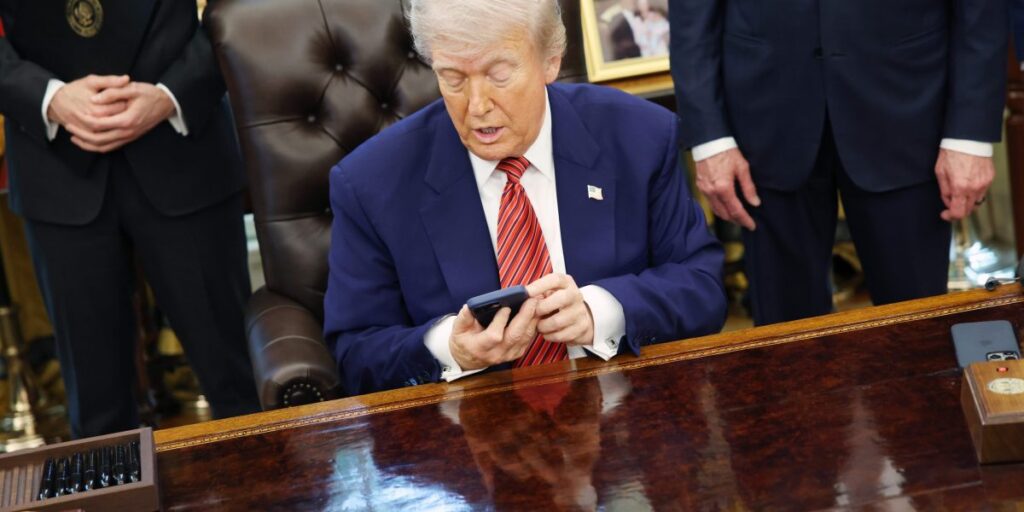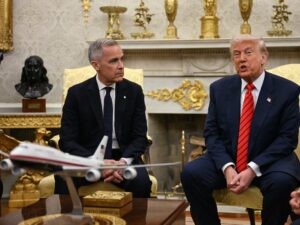
Analysts and supply chain experts are casting doubt on the Trump Organization’s recent claims that its new smartphone, the “T1,” will be “built in the United States.” Despite the company’s assertions, experts suggest the $499 device is more likely to be manufactured in China, potentially subjecting it to tariffs imposed by the Trump administration itself.
The Trump Organization, known for its real estate and hospitality ventures, announced on Monday that it would license its brand to a new wireless service called Trump Mobile. The gold-colored T1 smartphone is expected to launch in August, operating on the Google Android platform through a provider named Liberty Wireless. The announcement emphasized the phones as “proudly designed and built in the United States,” but industry insiders remain skeptical.
Manufacturing Realities and Expert Opinions
Blake Przesmicki, an analyst at Counterpoint Research, noted in a report that despite the marketing claims, the T1 is likely to be produced by a Chinese original device manufacturer (ODM), at least initially. “Despite being advertised as an American-made phone, it is likely that this device will be initially produced by a Chinese ODM,” Przesmicki stated.
Even if the U.S. had the capability to produce smartphones domestically, the Trump Organization would still need to import key components from overseas. This reality was acknowledged by Eric Trump, executive vice president of the Trump Organization, who admitted on a podcast that Trump Mobile would not be an entirely domestic endeavor at the outset.
Challenges in U.S. Production
President Donald Trump has long advocated for boosting domestic manufacturing, implementing tariffs to discourage foreign imports. However, experts like Dan Ives from Wedbush Securities have pointed out the significant hurdles in shifting production back to the U.S. For instance, Apple’s supply chain, deeply entrenched in China since the 1990s, would face prohibitive costs if relocated stateside.
“Generally, no phones have been manufactured in the U.S. since the 2G era in over a decade,” Przesmicki told Fortune. “We have weaker supply chains, fewer capable employees in the smartphone sector, lower margins.”
Leo Gebbie, principal analyst at CCS Insight, expressed skepticism about the feasibility of U.S. production for the T1 phones. “The idea that this could be replicated in the U.S. in any sort of short- to medium-term timescale is fanciful,” Gebbie remarked, suggesting that final assembly might occur in the U.S. to skirt the need for full domestic manufacturing investments.
Tariffs and Their Implications
The Trump Organization’s strategy of importing components could inadvertently subject it to the tariffs designed to penalize companies for not manufacturing in the U.S. “This absolutely does raise the specter of the Trump Organization mobile falling foul of the tariffs that have been instigated by the Trump administration,” Gebbie noted.
These tariffs, including a potential 25% levy on smartphones not produced domestically, are part of President Trump’s broader trade policy. Last month, he threatened similar tariffs on Apple products unless the company increased its U.S. manufacturing footprint, despite Apple’s announcement of a $500 billion investment in U.S. plants over the next four years.
Strategic Messaging
Gebbie speculated that the Trump Organization’s emphasis on U.S. manufacturing might serve as a strategic message to larger tech companies. “Maybe it provides leverage for the Trump administration to go out to device-makers like Apple and Samsung and say, ‘Hey, we are making smartphones in the U.S. Why aren’t you?’” he suggested.
Looking Ahead
As the August launch of the T1 approaches, the Trump Organization faces the dual challenges of meeting its domestic manufacturing claims and navigating the tariffs that could impact its bottom line. The situation underscores the complexities of the global supply chain and the difficulties of re-establishing a robust manufacturing base in the United States.
In the coming months, industry watchers will be keenly observing how the Trump Organization manages these challenges, and whether its efforts will indeed spur a broader movement towards domestic production in the tech industry.







